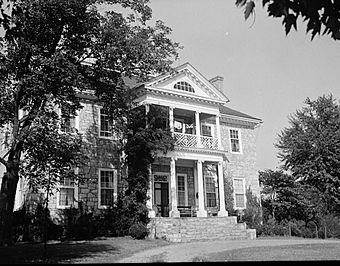Annefield (Boyce, Virginia) facts for kids
|
Annefield
|
|

Annefield, HABS Photo
|
|
| Location | E of jct. of Rtes. 633 and 652, near Boyce, Virginia |
|---|---|
| Area | 350 acres (140 ha) |
| Built | c. 1790 |
| Built by | Page, Matthew |
| Architectural style | Federal |
| NRHP reference No. | 69000231 |
Quick facts for kids Significant dates |
|
| Added to NRHP | November 12, 1969 |
Annefield, also known as Annfield, is a historic plantation house located near Boyce in Clarke County, Virginia. Matthew Page (1762–1826) started building it around 1790. He named it after his wife, Ann Randolph Meade (1781–1838), whom he married in 1799. Ann was the daughter of Richard Kidder Meade.
Contents
History of Annefield
Building a Large Estate
Matthew Page was born in Hanover County. He moved with his brother to what was then the frontier area of Frederick County. This area later became Clarke County. Matthew Page became one of the wealthiest people there.
He bought a large farm estate on the road between Alexandria and Winchester. He made his property much bigger, growing it to over 2,000 acres. He used about 200 enslaved people to work on this large farm.
Ann Page's Efforts to Help Enslaved People
Matthew Page's wife, Ann Meade Page, became a strong supporter of ending slavery. She was one of the leading anti-slavery activists in the South. However, her husband did not allow her to free enslaved people during his lifetime.
Ann Page's good friend, Molly Custis, also opposed slavery. Molly freed her own enslaved people. She also convinced her husband, George Washington Parke Custis, to free the rest of his enslaved people in his will.
Molly Custis's daughter, Mary Custis (1808-1873), was born at Annefield. This happened during one of her mother's visits. Mary Custis later became the wife of Robert E. Lee.
Ann Page faced criticism from her neighbors. They sometimes called her "slave to the slaves" because of her actions. She replaced the living areas for enslaved people at Annefield. She also taught African Americans on the plantation, even those who were not enslaved there.
Both Ann Page and Molly Custis were active in the American Colonization Society. This group aimed to help free African Americans move to Liberia in Africa. Reverend Charles Wesley Andrews, who helped at the local church, also joined this society. He later married Ann Page's daughter, Sarah.
After Matthew Page's Death
Matthew Page passed away in 1826. His will was very detailed. It divided the enslaved people among his wife, daughter Sarah, nephews, and niece. Ann Page received some money from the estate. She used this money to care for elderly enslaved people.
Between 1832 and her death in 1838, Ann Page sent three groups of enslaved people from Annefield to Liberia. This included 34 people. In her will, she also gave others the choice to go to Liberia. Reverend Andrews helped carry out her will.
After Ann Page's death, Annefield was sold to Thomas Carter. His son, William Page Carter (born 1840), became a Captain in the Confederate Light Artillery. He was injured in a battle near Richmond. After his injury, he started writing poetry. He later married Lucy Page and lived in Washington, D.C. His book of poems, Echoes from the Glen in Divers Keys (1905), can be found online.
Architecture of Annefield
The main house at Annefield is a two-story stone building. It has seven sections across the front and four sections along the sides. The roof is sloped on all sides. The main entrance has a porch with two levels. This porch is supported by Roman Ionic columns.
Later, a smaller, one-and-a-half-story addition was built at the back. This part is made of wood and covered in stucco. Inside the house, there is a lot of detailed carved woodwork. This includes decorative moldings and a balustraded deck. The house also has four chimneys inside. There is also a separate kitchen building on the property.
Annefield was added to the National Register of Historic Places in 1969. This means it is recognized as an important historical site.




